In February 2024, Safran Vectronix AG revealed the creation of a new commercial unit dubbed Vectronix Shooting Solutions under which they are releasing a new rangefinding binocular called the Vector X. For those unaware of Safran Vectronix, they are a Swiss company focused on developing optical-electronics products for military defense. Their most well-known product up until recently is arguably the Terrapin laser rangefinder (which is now sold under the Vectronix Shooting Solutions name) as the Terrapin was considered the best handheld laser rangefinder for several years.
The creation of Vectronix Shooting Solutions marks a new era for Safran Vectronix within the commercial sector and the announcement of the Vector X rangefinding binocular in early-2024 has made a huge splash.

Vectronix created a buzz with the initial press release in February and then even more buzz with their website, social media posts, and YouTube videos released by those with early-access hyping the features and functionality of the Vector X.
Rangefinding binoculars have been getting more focus in recent years as hunters and long range shooters are seeing the value of a single unit combining the features of a laser rangefinder monocular with a standalone binocular. Field matches like NRL Hunter have also created more demand for rangefinding binoculars, as these are vital to successfully locating and rangefinding the targets under a time limit.
Thus, the amount of buzz that the Vectronix Vector X created at the start of 2024 built exponentially throughout the year as people began placing pre-orders with authorized dealers.
In 2023, I already went through a long decision process on selecting a laser rangefinding binocular and acquired the SWAROVSKI OPTIK EL Range TA 10×42 which have proven to be a superb optic with highly effective rangefinding and ballistics features. Yet the new features of the Vector X were very attractive and I decided that I wanted to try these out myself. Since I’m not big enough in the industry to get early access, I had to pre-order like everyone else and buy them at retail price to get my hands on one.
By way of CS Tactical, I was able to score a set of the Vectronix Shooting Solutions Vector X binoculars in 10×42 with the MSR-DMR reticle.
The general specifications for the Vector X 10×42 SMR-DMR are:
- Magnification: 10x magnification
- Objective: 42mm
- Field of view: 330ft at 1000 yards, 110 meters at 1000 meters, 6.3 degrees
- Eye relief: 17mm eye
- Interpupillary distance: 58 to 78mm
- Twilight number: 20.5
- Range: 3 yards to 2400 yards (deer) / 3000 yards (tree) / 7000 yards (reflective)
- Accuracy: +/- 1 meter between 9m and 100m, +/- 2 between 100m and 500m
- Beam divergence: 1.8 x 0.1 MRAD
- Dimensions: 156mm x 130mm x 56mm / 6.14 in x 5.12 in x 2.20 in
- Weight: 977 grams / 34 oz (without battery)
The specifications of the Vector X are good and compare similarly to what is already on the market. However, the extensive features are what bring more attention to this rangefinding binocular.
First and foremost the Vector X rangefinding binocular has the Applied Ballistics Elite ballistic solver onboard. While there are other solvers integrated with rangefinders that also work effectively, Applied Ballistics continues to be the standard by which all others are compared to.
In conjunction with onboard Applied Ballistics Elite, the Vectronix Vector X has onboard environmental sensors for temperature, humidity, and barometric pressure along with a compass and inclination/declination measurement. Aside from wind, the Vector X should provide the shooter a complete ballistic solution all within the unit.
The Vector X comes with one of two etched reticles in the right barrel, both options have a center etched crosshair for aiming the laser.
The first reticle option is what is referred to as the MSR-SMR and is a more traditional L-style MIL reticle.
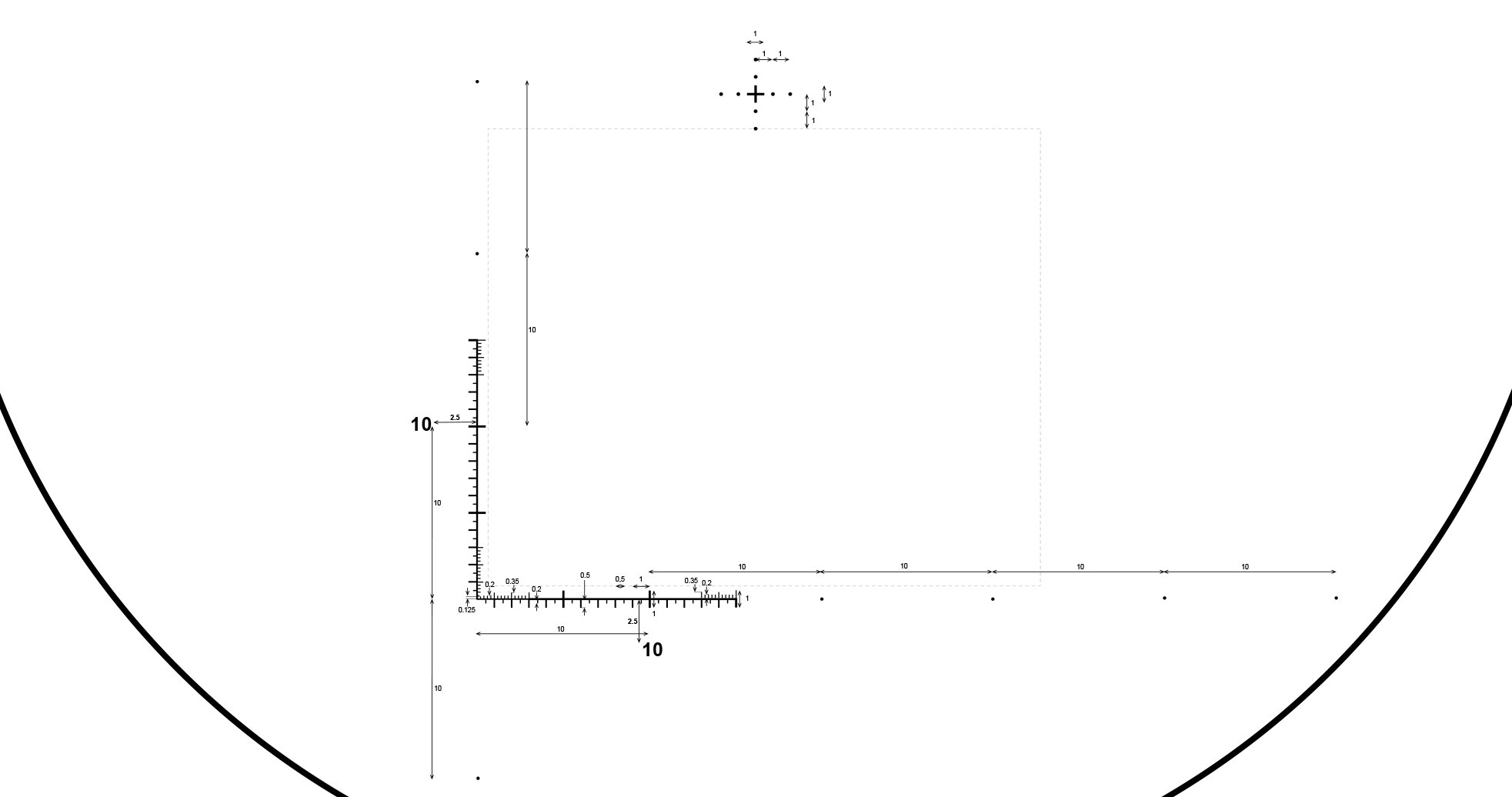
The second reticle option is what I referred to as the MSR-DMR and is the option I chose.
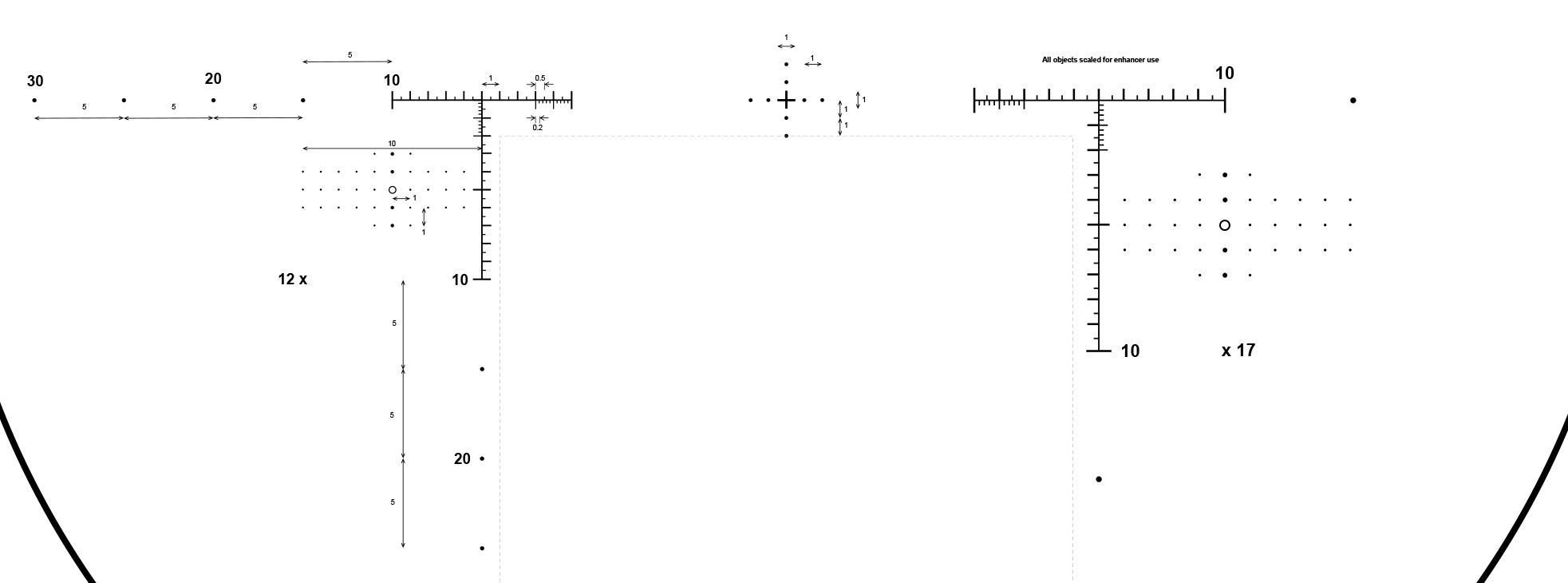
There are actually two reticles in the MSR-DMR where the one on the left is scaled for the magnification of the binocular and the one on the right is for use with the range enhancers.
The Vector X is currently available in 8×42, 10×42, and 12×42. All three can accept the Vector X range enhancer accessory which thread onto the objective lenses and act as a 1.4x magnifier. The 8×42, 10×42, and 12×42 become 11×42, 14×42, and 17×42, respectively.
Since the Vector X has etched reticles for milling, a magnification change will make a milling reticle unusable, which is why the MSR-DMR has two reticles, one for the normal magnification and the other for with use with the 1.4x magnifier.
While I did not buy the range enhancers and likely never will, the option to use them while retaining the use of the reticle pushed me towards the MSR-DMR reticle.
The battery used by the Vectronix Vector X is a deviation from commercial, consumer laser rangefinders which typically use a CR2, as the Vector X can use either the common CR123A or the less common 18650. CR123A batteries have become ubiquitous due to use in modern handheld flashlights and weaponlights, and as a result, shooters often have many CR123A on hand. Whereas with the CR2, these batteries are only really used in laser rangefinders, so keeping spare CR2 batteries around adds overhead.
As mentioned, the Vector X can also run on a single 18650 battery which can be loosely referred to as equivalent to two CR123A batteries (many lights that use two CR123A batteries can use one 18650 battery instead). The 18650 is less common than a CR123A, but is becoming more prevalent as they last longer and are readily available in rechargeable form.
In order to facilitate the 18650 battery, the Vector X includes a second battery door/cover for use with an 18650, along other accessories such as objective covers and a neck strap, among other items.
The Vector X comes with front lens flip covers which are hard plastic unlike the rubber covers found on most other binoculars.
The covers press fit into the front of the binocular and it appears they are retained by the rubber armor that protrudes from the objective lens side.
I have always found front covers on most binoculars to be pretty lackluster as they seem to pop open when you don’t want them to, such as when you pull the binocular out of a chest harness or pouch. Since the rubber armor creates the lip for front flip covers to press into, I am curious to see how well they retain on the objective.
I have played around with the covers flipping them open and closing them repeatedly and they seem to stay on the binocular well enough. While you can orient them any way you want on the 360 axis and they will flip flush to the body (except the 12 o’clock position because of the armor design shape on the objective side), the side and bottom flip orientation result in the covers being within the grip of the hands as you hold the binocular.
Note that the front objective have a M46×0.75 threads which can accept the aforementioned range enhancers as well as anti-reflection devices (ARD) from Tenebraex and anyone else that wants to make accessories to fit that thread pitch.
The Vectronix Shooting Solutions Vector X also comes with a tripod adapter. However, it is a very basic plate that attaches to the bottom of the right barrel that adds a 1/4″-20 thread to attach it to a standard 1/4″-20 post on a tripod or to an adapter plate for a tripod head.
Of course, this is very rudimentary and people will prefer a direct Arca-Swiss style dovetail adapter. Thankfully, Really Right Stuff created a Vector X mount in collaboration with Vectronix.
The RRS Vector X mount is an adapter for Arca-Swiss style clamps using the RRS dovetail standard (1.5″ and 45 degrees) and it has a very interesting saddle design which allows the binocular to be adjusted appropriately on the tripod for the user’s interpupillary distance.
The issue with binoculars that are attached to a tripod on one of the barrels is that when you adjust the bridge to spread out or bring in the barrels for the user’s interpupillary distance, the binocular barrels will not be level with one another and you have to adjust the tripod head.
But with the RRS Vector X mount, it is actually a plate that clamps into the head while the second piece sits in that plate like a saddle, so it can ‘rock’ in the saddle allowing the binocular to cant without moving the orientation of tripod head. Thus, the tripod had can remain level and the binocular can also be leveled regardless of the interpupillary distance.
Furthermore, the RRS SOAR Vector X mount is RRS-Lock compatible for anti-slip. The RRS SOAR Vector X mount is a separate product sold by RRS and is not included with the Vector X.
When I unboxed the Vectronix Shooting Solutions Vector X, it was inside a padded Cordura MOLLE compatible soft case.
The case is a nice touch and is definitely oriented more for anyone that wants to keep their binocular inside a pack (or outside via MOLLE). I am personally going to be keeping this in a chest harness so I will not be using the case.
The Vector X has a rubberized armor skin that feels stiff and slick to the touch. It does not feel as comfortable as a Swarovski Optic and is more on par with how a SIG KILO or Vortex Optic binocular holds in the hand.
While the Vector X is about the same size and weight as any other 10×42 laser rangefinding binocular, the full hinged bridge from the focus knob to the front of the binocular factors into a bulky feel in the hands as you can’t wrap your hands around the barrels like with a split bridge.
The focus knob is smooth but has a spongy tension when the turn of the knob starts. It is almost like a dead space in the knob where it can turn a degree or two left and right before the resistance of the focus knob is felt. It feels a little odd but I wonder if this was by design to allow for very fine focus adjustments, which may be needed because of what I perceive to be very fast travel in the focus knob.
I noticed that the focus knob does have much range in the physical revolution; only about one an a third revolutions. The binoculars do focus from a minimum focal range if about 7 yards (even though specs say 9 yards) to infinity. However, the amount of turn in the focus knob to focus is very slight. It does make for a quick focusing action from near to far, but it could impact the ability to fine focus in stress conditions.
The diopter adjustments are non-locking and have a good amount of resistance to turn which should keep them from inadvertently moving. There is an index mark on each diopter on the 6 o’clock position so adjustments can be remembered.
The eye cups have three settings, fully compressed, fully retracted, and two settings in between.
The buttons have a decent feel to them and take distinct, intentional pressure to actuate the buttons. The right button turns on the heads up display (HUD) and activates the laser rangefinder to take a measurement. The left buttons are used to activate and navigate the menu system in the HUD.
However, I feel that the right button isn’t positioned very well. When I pick up the Vector X and bring them to my eyes, the button is nowhere close to the tip of my index finger and I have really curl my finger to get to it. Not to mention, it’s more forward than where my hands naturally grip the binocular.
While the button looks relative large, the actually area of the button that actuates to pressure is small and is literally where the red dot is. So the large black square/diamond is more for form than function.
I have smaller than average hands so if this is an issue observed by me, I can’t imagine how other people with larger hands find this.
Accessing menu system is not immediately intuitive and reading the manual will help gain an understanding on how to bring up certain screens. But once you remember the sequences necessary to bring up specific menus, you can navigate the HUD easily with the directional buttons.
The Vectronix Shooting Solutions data sheet states that the time to measure distance is less than 0.25 seconds. It is definitely under one second after the button is depressed, but I honestly feel like it is longer than a quarter of a second.
Testing of the laser rangefinder functionality has shown that it is centered up with the reticle. Note that I was finding it to be a little left of center but that when I was ranging with the barrels of the binocular set close together for my interpupillary distance. In this setting, the reticle is canted/rotated about 10 degrees clockwise.
When I leveled the reticle (approximate, going off light poles) and tested the rangefinder, the laser appeared to centered up. This could indicate that the laser is a little low from center which could explain why it would be hitting slightly left of center when canted right/clockwise.
As far as the ranging distance, I have been able to get distance readings on small non-reflective objects beyond 2000 yards, trees and foliage at 3000, and on some highly reflective beyond 6000. This was all informal testing carrying the binoculars in a pack whenever I go somewhere and doing on-the-fly rangefinder tests.
One item to note is that when the display turns off after the timeout, after no buttons are pressed for X amount of time (where X is either 5, 10, 20, 30, or 60 seconds), there is a delay to get the system active again. When the HUD is off, it is in a quasi ‘sleep’ mode and pressing the activation button wakes it up and it takes about 2 seconds for it the HUD to go live.
The Applied Ballistics Elite solver does not really need much discussion. It is the same software found on other devices including the Kestrel 5700 Elite. What does bear discussion is the onboard environmental sensors that feed data to the solver to generate a truer ballistic solution.
I have found that the sensors are relatively accurate to local station data and live Kestrel data. However, it does take a good amount of time for the temperature sensors to catch up to ambient temperature. I walked outside on a 95F degree day from indoors and set the Vector X on a tripod in the shade (backyard patio). It took about 30 mins for the temperature data to match the ambient temp (indoor 75F to outdoor 95F under shade).
With a Kestrel 5700, you typically swing/twirl the unit around on a lanyard so you can get the ambient air flowing past the sensors and this can get the readings accurate after 7-10 rotations. With the Vector X, you really can’t do this as the sensors at the front and are underneath the rubberized outer armor (with vent holes for the sensors). So you need to be aware of where the Vector X have been kept prior to using the ballistic solver.
The Vectronix Shooting Solutions phone app is a critical aspect to configuring the Vector X as you will use this app to create the gun profiles that will get synced to the Vector X.
The manual does not indicate if there is a limit on the number of gun profiles that can be stored in the Vector X at one time. However, Vectronix support indicated that the Vector X can store 30 gun profiles onboard.
Selecting the active profile in the binocular is simple through the menu system in the HUD.
The VECSS smartphone app is not only used to create and load gun profiles to the Vector X unit, it can be used to configure the unit settings as well.
Lastly and by far not the least item to cover is the image quality. A lot of the people with early access to the Vector X months prior to the general release all spoke positively of the Vector X image quality. From what I gathered, the general consensus is that the image quality is very good. Not equal to a Swarovski Optik binocular, but very close to it.
When I saw those opinions in videos and published posts, I was a bit skeptical because I have a pretty discerning eye when it comes to image quality.
So far, I have found that the pre-release / preview opinions on image quality were relatively accurate. I have found that the image quality in the Vector X to be clear and crisp in various lighting conditions. There is the expected barrel distortion at the edges, but the clarity of the image doesn’t necessarily fall of at the edges.
The depth of field appears to be quite deep. I mentioned earlier that the focus knob does not have much of a physical rotation range and focus is immediate. What I also noticed is that when focusing further out (past 600 yards), the areas in front and behind are still in relative focus and I can scan in front and behind a point without having to touch the focus knob.
I wasn’t seeing much chromatic aberration and the resolution on some test targets looked solid.
Of course, people will want to know if the Vector X has the dreaded blue tint that is common with laser rangefinders, either monocular or binocular.
Yes, there is a blue tint in the right barrel. However, you will not really notice it and it only became apparent when I looked at each barrel independent of one another, looking through the right lens only then the left lens only, and repeating. The left barrel is true to color while the right barrel has a subdued color due to the presence of a blue tint as a byproduct of the LED HUD in the right barrel.
Compared to a SIG KILO10K which is arguably one of the worst blue tints you’ll find in a range finding binocular, the Vector X is leaps and bounds above in terms of the blue tint and image quality. Note that I have not had time behind the KILO10K Gen 2, which supposedly improves the blue tint problem.
With all the specifications and features discussed, what is my overall opinion on the Vectronix Shooting Solutions Vector X 10×42 rangefinding binocular?
First and foremost, I feel that the image quality is above average and is acceptable for an observation optic. I’ve looked through some Leica binoculars (not the Geovid Pro) and I feel these are going to compare on par with Leica. It’s not quite on par with Swarovski Optik because I feel the field flattening technology (aka Swarovision) really gives the EL Range TA and NL Pure a significant edge to other binoculars in terms of image clarity and rendition.
It’s not fair to compare the color rendition between a Swarovski and the Vector X due to the HUD used for the right barrel and the compromises made for the readability of the HUD. But I feel the left barrel color is not too bad in comparison to Swarovski.
Aside from the feel of the focus knob when rotating it starting from a dead stop, the knob is smooth throughout and I can focus quickly to distance. The depth of field I am noticing in the Vector X is quite impressive and scanning front to back / back to front is made easier.
The laser rangefinder seems to be dead on and I have full confidence in it. Granted, I did not get trees out to 3000 yards during my testing. I found that 2700 yards was about the maximum distance I could read on a tree. Although, I have been testing in warm/hot, sunny and hazy conditions.
The phone app and the integration with the binocular along with Applied Ballistics Elite works seamlessly. Getting the profiles from the phone app to the binocular is effortless and selecting profiles in the binocular HUD is simple.
The rangefinder and the ballistic solver are fast (well under a second) and there’s no real lag time to get the firing solution.
The menu system is easy to navigate and the HUD is very easy to read and use. I appreciate having all the data on a single screen with no need to wait for the display to cycle through data.
There is a target card feature that I think will be incredibly useful with some practice. If you are in a situation with multiple targets at varying distances, what you can do is get a value for each target and store them as targets for the internal range card and refer to them later. For example, you will bring up the target card input screen (hold down right arrow for 2 seconds).
Once the target card screen is up, you will use the right button to get a distance reading on the target and that is assigned to active target card.
Then you will move to the next target and before getting the new distance value, use the arrow keys to cycle to the next target.
Then after cycling to the next target card or ID, use the right button to get the distance value.
Repeat this process with any other targets you have in the array.
Once this is complete, you can exist the target card input screen and go to the regular display or to the Menu to get to the Target Card screen.
The Target Card screen will have all the targets that were put on the card during the input process displayed on screen, with not only the distance data but also the corresponding elevation and windage data, respectively.
The Target Card feature could be valuable in formats such as NRL Hunter, where you could be obtaining distances on up to four (4) targets in a given stage. While it is just as fast to write this data down as you glass for the targets in NRLH, it may be handy to have them stored in the binocular in the event you have an issue writing out the data by hand and can go back to the bino to quickly reference it.
I am not sure if this is possible yet, but if the Vector X could seamlessly update a Kestrel Ballistics HUD or E-Dope card that would make the Target Card system in the Vector X even more effective.
I will say that I’m still on the fence on the front flip covers. In theory and controlled environments they work great. However, I’m going to wait until I really use this in a field situation before I can render a verdict on the durability and functionality of the flip covers to see if they come off the objective completely or break under hard field use.
I like the ability to use CR123A batteries as well as the higher capacity 18650 battery. The one negative aspect is that you have to use the appropriate battery cover for the respective battery. Where this can be a problem is if you are in the field, your 18650 battery dies and you can’t recharge it (or don’t have time to) and only have CR123A batteries on-hand. Unless you are packing the battery cover for the CR123A, you’re out of luck. So you either carry spare 18650 batteries (more overhead) or stick to the CR123A cover an carry the more ubiquitous CR123A batteries.
The ergonomics of the Vector X are not very inspiring. The grip is not all that natural to me because of the full length bridge connecting the two barrels. This results in the buttons, primarily the rangefinder actuation button, not being in a location the finger naturally wants to press.
Even though the Vector X is dimensionally smaller than the Swarovski Optik EL Range TA 10×42, I find that the Vector X just feels bulkier in the hands because of the full bridge hinge design. I like the split bridge design where you can get your hands around the barrels of the binocular for a better grip.
While it feels bulky in the hand, it does not translate to bulkiness when stowed. Even with the tripod adapter, it is on par with any other binocular dimensions.
The included tripod adapter is very generic. While I feel it’s so basic that they may as well not have included it, it makes sense to at least provide some option for people. However, I feel that anyone who gets the Vector X should not bother with the bundled tripod adapter and get the RRS SOAR Vector X mount, if not the Area 419 Vector X Arcalock mount.
Note that you will have to crack open the individually packaged factory tripod adapter because you need to use the four screws in that package to install the RRS SOAR Vector X mount.
There is one big elephant in the room and that is customer support. Historically, Safran Vectronix has a poor reputation for customer service on the general civilian consumer market. As mentioned earlier, Safran Vectronix at its core is defense contractor and its primary customer will be militaries around the world. Whenever someone broke a Safran Vectronix Terrapin laser rangefinder, the tongue-in-cheek response is that you know have an expensive paperweight because you weren’t going to get any service support.
The Vector X is released under the Vectronix Shooting Solutions name and a press release stated the following:
VECTRONIX SHOOTING SOLUTIONS is a business unit of Safran Vectronix AG, a global leader in state-of-the-art electro-optical equipment, systems, and sensors for military and civilian applications. More than 100 years of Swiss radition and excellence in optics and precision engineering are reflected in our products – handheld laser rangefinders and night vision devices, tripod-mounted orientation and positioning systems and sensor modules for our OEM partners.
Furthermore, the Vectronix website states:
When US soldiers, who had employed our rangefinding devices during their service, transitioned back to civilian life and started to compete in the growing sport of long-range shooting, many of them expressed a strong desire to continue utilizing Vectronix products. This inspired us to begin developing top-tier electro-optical devices tailored specifically for the most discerning long-range shooters and hunters. VECTRONIX SHOOTING SOLUTIONS was born.
The TERRAPIN X and VECTOR X series are only the beginning of this new chapter in our company’s history and we hope that you are just as excited about what lies ahead for VECTRONIX SHOOTING SOLUTIONS as we are.
It appears that the creation of Vectronix Shooting Solutions under Safran Vectronix signals a renewed focus on the civilian consumer market segment and that customer support will be improved. The odd thing is that there is no warranty information in the box and I had to go dig up information on the website.
The FAQ states:
The terms and conditions depend on the applicable regulations in the country where you purchased your VECTOR X. In general, however, when purchasing a VECTOR X, you’ll receive a 3-years warranty for the electronics and a 10-years warranty for the optics and mechanics, excluding misuse.
That being said, I did file a customer support request via their website because the 18650 battery cap was broken in the package (spring was not attached internally). Four (4) days after I filed the support request I received a response and the support representative arranged for a new cap to be sent out, straight from Switzerland. The replacement part actually only took two business days to be delivered.
Does the Vectronix Shooting Solutions Vector X live up to the hype?
Yes, I have to say it does. The Vector X is arguably the most complete and balanced rangefinding binocular package to date combining high image quality with a high performing rangefinder, the Applied Ballistics Elite ballistics solver, an etched milling reticle, the ability to customize with threaded accessories, and an easy to use smartphone app.
Pros:
- Above average image quality and resolution
- Good depth of field
- Easy / fast focus
- Reliable laser rangefinder
- Applied Ballistics and environmental sensors onboard
- Tripod adapter support
- CR123A battery support (or 18650)
- Target card system
Cons:
- Ergonomics – Feels surprisingly clunky and buttons not located well for hands
- Startup delay if HUD/display is off (~2 seconds)
- Minor blue tint in right barrel due to film for HUD
The Vectronix Shooting Solutions Vector X carries a $2799/$2899 price tag and is comparable in price to the SIG KILO10K-ABS HD Gen 2 10×42 (MSRP $3499 USD, street ~ $2699 USD), the Leica Geovid Pro 10×42 (MSRP $3399 USD, street ~ $2750 USD), and the Revic Acura BLR10b 10×42 (MSRP $2695 USD). In that regard, the Vector X is likely going to be an attractive choice out of these options given the feature set and optical performance.
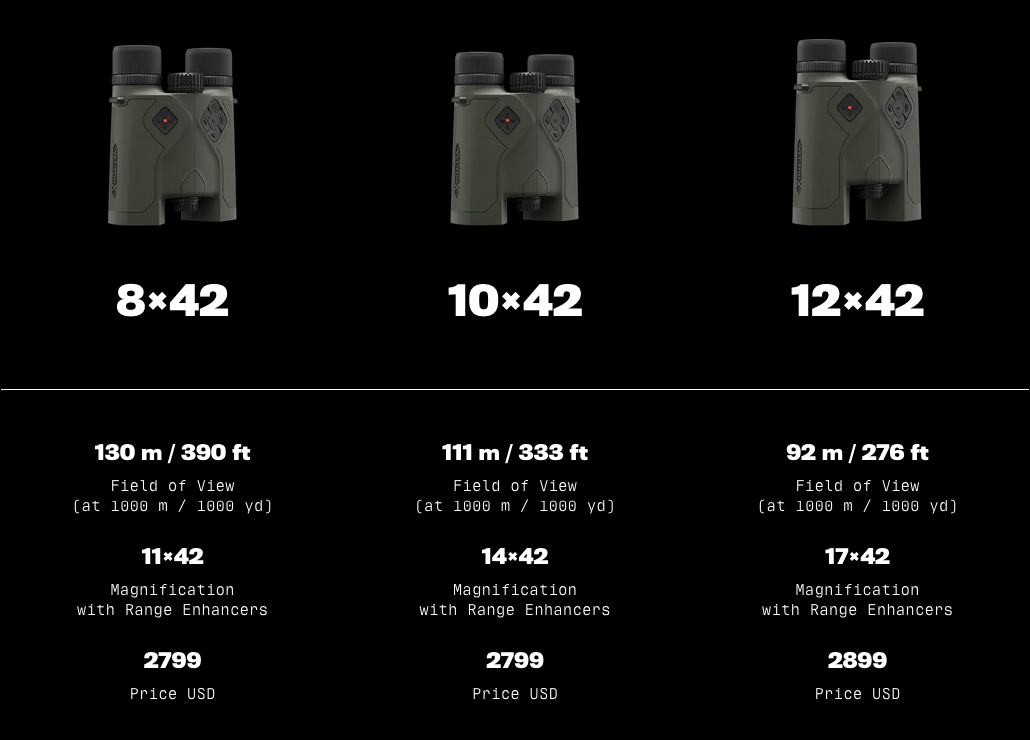
As far as the Swarovski Optik EL Range TA 10×42 (MSRP $3999 USD, street ~ $3499 as of 2024-10-01) which I do own, I feel like the Vector X has just enough in image performance department that I want to use them over the EL Range TA for the other tangible features. In my short time using the Vectronix Shooting Solutions Vector X, I have not thought to myself, “The image in the Vector X is not looking good right now. Let me reach for my EL Range TA.”
When I bought the EL Range TA 10×42, I chose it because the other rangefinding binoculars did not have enough features to balance out their comparatively lesser optical performance (to the EL Range TA). Now given the choice between the EL Range TA and 10×42 and the Vector X, I feel that choice is now swayed towards the Vectronix Vector X.
Suffice it to say, if you are a precision long range shooter that wants a laser rangefinding binocular that encapsulates Applied Ballistics, onboard environmental sensors, an etched reticle, and a robust heads up display all with a superb laser rangefinder and top tier image quality, you should consider the Vectronix Shooting Solutions Vector X.
If you prioritize the best image quality available while still having a rangefinder built-in, the Swarovski Optik EL Range TA is still the go to unit. The EL Range TA is going to give you best in glass optical performance with a very good and responsive laser rangefinder and a functional, albeit basic, ballistic solver.
As of the time this article is being released (October 2024), the Vectronix Shooting Solutions Vector X more units are making it to retailers and the MSR-DMR reticle appears to be the most popular option as those are often sold out.
If you are interested in the Vectronix Shooting Solutions Vector X, inquire a trusted optics dealer who carries Vectronix products, such as CS Tactical – https://cstactical.com.
With all this said, I will be running the Vectronix Shooting Solutions Vector X 10×42 MSR-DMR in the next NRL Hunter match I can attend in 2025. After multi-stage NRL Hunter match, I will add an update to this article with how it performed.


Comment on this post